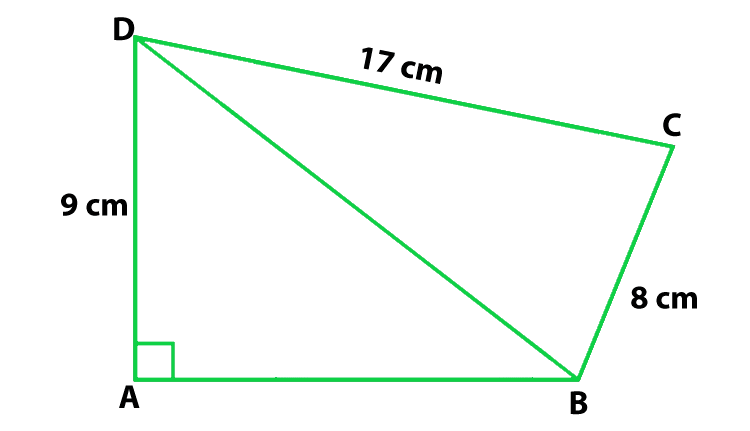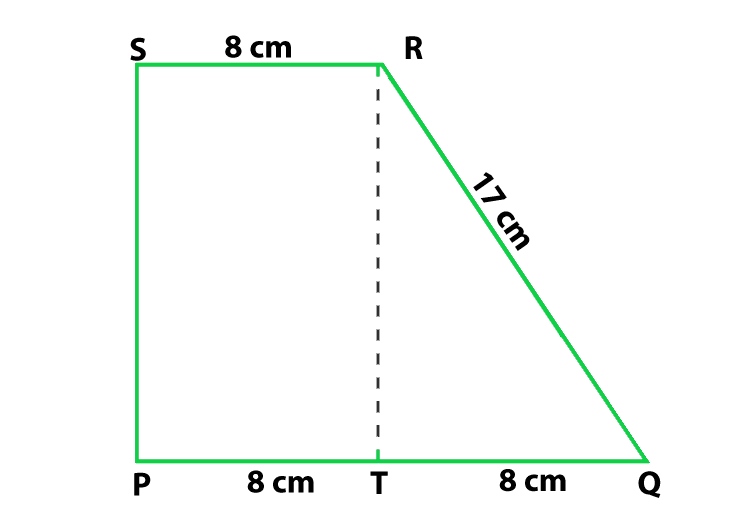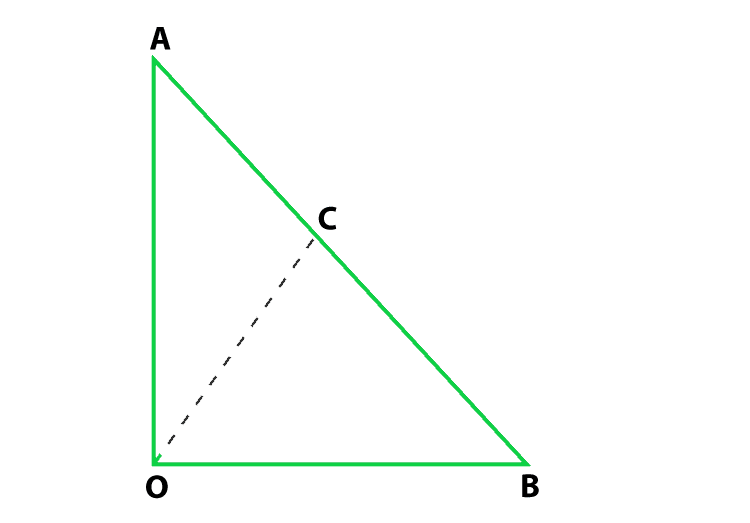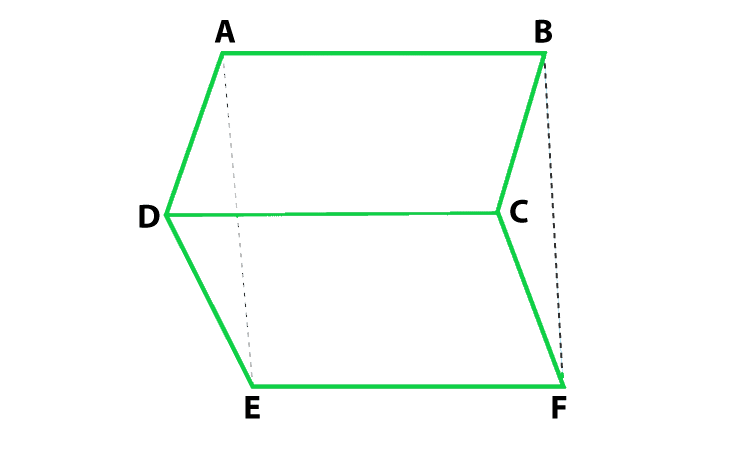问题1.在图中,计算四边形ABCD的面积。

解决方案:
According to the question
DC = 17 cm, AD = 9 cm and BC = 8 cm
Find: the area of quadrilateral ABCD
In ΔBCD,
Using Pythagoras Theorem
CD2 = BD2 + BC2
172 = BD2 + 82
BD2 = 289 − 64
BD = 15
So, the area of ΔBCD = 1/2(8 × 17) = 68
In ΔABD
Using Pythagoras Theorem
AB2 + AD2 = BD2
152 = AB2 + 92
AB2 = 225 − 81 = 144
AB = 12
So, the area of ΔABD = 1/2(12 × 9) = 54
Now we find the ar(quad ABCD) = ar(ΔABD) + ar(ΔBCD)
ar(quad ABCD) = 54 + 68 = 122 cm2
Hence, the area of quadrilateral ABCD is 122 cm2
问题2。在图中,PQRS是一个正方形,T和U分别是PS和QR的中点。如果PQ = 8 cm,则找到ΔOTS的面积。

解决方案:
According to the question
T and U are mid-points of PS and QR
Hence, TU ∥ PQ
PQ = 8 cm
Find: the area of ΔOTS
In ΔPQS,
It is given that T is the midpoint of PS and TO ∥ PQ
therefore, TO = (1/2) PQ = 4 cm
and TS = (1/2) PS = 4 cm
So, the area of ar(ΔOTS) = (1/2)(TO × TS)
= (1/2)(4 × 4) = 8 cm2
Hence, the area of ΔOTS is 8 cm2
问题3.计算图中梯形PQRS的面积

解决方案:
According to the figure
PQ = 16 cm
Here T is the mid-point of side PQ so
PT = QT = 8 cm
SR = 8 cm
RQ = 17 cm
Find: the area of trapezium PQRS
So, the ar(trap. PQRS) = ar(rect. PSRT) + ar(ΔQRT) ….(1)
So, In ΔQRT
Using Pythagoras Theorem
QR2 = QT2 + RT2
RT2 = QR2 − QT2
RT2 = 172 − 82 = 225
RT = 15
So, the area of ΔQRT
= 1/2(QT × RT) = 8 × 15 = 180/2 = 60
Now we find the area of rectangle PSRT
= PT × RT = 8 × 15 = 120
Now put all these values in eq(1), we get
ar(trap. PQRS) = 120 + 60 = 180
Hence, the area of trapezium is 180 cm2
问题4.在图中,, AOB = 90°,AC = BC,OA = 12 cm,OC = 6.5 cm。找出ΔAOB的面积。

解决方案:
According to the question
∠AOB = 90°, AC = BC, OA = 12 cm and OC = 6.5 cm
Find: the area of ΔAOB
From the figure, C is the mid-point of hypotenuse AB so in right triangle
the mid-point is equidistant from the vertices
therefore, CA = CB = OC
CA = CB = 6.5 cm
AB = 13 cm
In ΔOAB,
Using Pythagoras Theorem
AB2 = OB2 + OA2
132 = OB2 + 122
OB2 = 132 − 122 = 169 − 144 = 25
OB = 5
Now we find the area of ΔAOB = (1/2)(12 × 5) = 30 cm2
Hence, the area of ΔAOB is 30 cm2
问题5.在图中,ABCD是一个梯形,其中AB = 7 cm,AD = BC = 5 cm,DC = x cm,AB与DC之间的距离为4 cm。求出x的值和梯形ABCD的面积。

解决方案:
According to the question
AB = 7 cm, AD = BC = 5 cm
Construction: Draw AL ⊥ DC, BM ⊥ DC,
AL = BM = 4 cm and LM = 7 cm
Find: the value of x and area of trapezium ABCD.
In Δ ADL,
Using Pythagoras Theorem
AD2 = AL2 + DL2
25 = 16 + DL2
DL = 3 cm
Similarly,
MC = √BC2 – BM2 = √25 – 16 = 3 cm
So, x = CD = CM + ML + LD = (3 + 7 + 3) cm = 13 cm
Now we find the area of trapezium ABCD = 1/2(AB + CD) × AL
= 1/2(7 + 13) × 4 cm2 = 40 cm2
Hence, the value of x is 3 cm and the area of trapezium is 40 cm2
问题6.在图中,OCDE是一个矩形,刻在半径为10 cm的圆的象限中。如果OE =2√5cm,则找到矩形的面积。

解决方案:
According to the question
OD = 10 cm and OE = 2√5cm
Find: the area of the rectangle OCDE
So, In ΔDEO
By using Pythagoras theorem
OD2 = OE2 + DE2
DE = √OD2 – OE2
= √102 – (2√5)2 = 4√5 cm
Now we find the area of rectangle OCDE = OE × DE
= 2√5 x 4√5 cm2 = 40 cm2
Hence, the area of rectangle is 40 cm2
问题7。在图中,ABCD是一个梯形,其中AB∥DC。证明ar(ΔAOD)= ar(ΔBOC)

解决方案:
According to the question
ABCD is a trapezium in which AB ∥ DC
To prove : ar(ΔAOD) = ar(ΔBOC)
Proof :
According to the figure, we conclude that ΔADC and ΔBDC are on the
same base DC and between same parallels AB and DC
So, ar(ΔADC) = ar(ΔBDC) ….(1)
Here, ar(ΔADC) = ar(ΔAOD) + ar(ΔDOC)
Similarly, ar(ΔBDC) = ar(ΔBOC) + ar(ΔDOC)
Now put all these values in eq(1), we get
ar(ΔAOD) + ar(ΔDOC) = ar(ΔBOC) + ar(ΔDOC)
ar(ΔAOD) = ar(ΔBOC)
Hence, proved
问题8.在图中,ABCD,ABFE和CDEF是平行四边形。证明ar(ΔADE)= ar(ΔBCF)。

解决方案:
According to the question
ABCD is parallelogram, so, AD = BC
CDEF is parallelogram, so, DE = CF
ABFE is parallelogram, so, AE = BF
Prove: ar(ΔADE) = ar(ΔBCF)
Proof:
In ΔADF and BCF,
AD = BC,
DE = CF
AE = BF
So, by SSS congruence,
ΔADE ≅ ΔBCF
So, ar(ΔADE) = ar(ΔBCF)
Hence, proved
问题9.四边形ABCD的对角AC和BD在P处相交。表明:ar(ΔAPB)×ar(ΔCPD)= ar(ΔAPD)×ar(ΔBPC)。
解决方案:
Construction : Draw BQ ⊥ AC and DR ⊥ AC
Prove: ar(ΔAPB) × ar(ΔCPD) = ar(ΔAPD) × ar(ΔBPC)
Proof:
Lets take L.H.S
= ar(ΔAPB) × ar(ΔCDP)
= (1/2) [(AP × BQ)] × (1/2 × PC × DR)
= (1/2 × PC × BQ) × (1/2 × AP × DR)
= ar(ΔAPD) × ar(ΔBPC)
L.H.S = R.H.S
Hence proved
问题10.在图中,ABC和ABD是基础AB上的两个三角形。如果线段CD被AB在O处平分,则表明ar(ΔABC)= ar(ΔABD)。

解决方案:
According to the question
ABC and ABD are two triangles on the base AB
and CD is bisected by AB at O,
To prove: ar(ΔABC) = ar(ΔABD).
Construction: CP ⊥ AB and DQ ⊥ AB.
Proof:
First we find the area of ΔABC = 1/2 × AB × CP …..(i)
Now we find the area of ΔABD = 1/2 × AB × DQ …..(i)
So, in ΔCPO and ΔDQO,
∠CPO = ∠DQO (Each 90°)
CO = OD (Given)
∠COP = ∠DOQ (Vertically opposite angles are equal)
So, by AAS congruency
ΔCPO ≅ ΔDQO
So, by C.P.C.T
CP = DQ …..(iii)
So, from equation (i), (ii), and (iii)
ar(ΔABC) = ar(ΔABD)
Hence proved